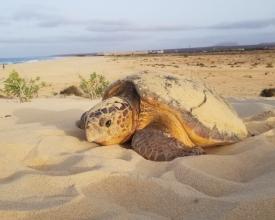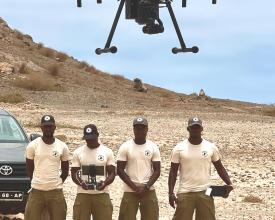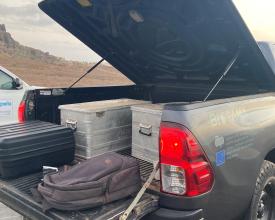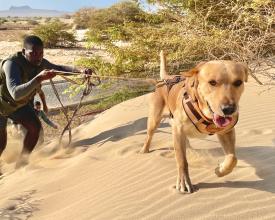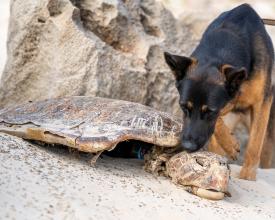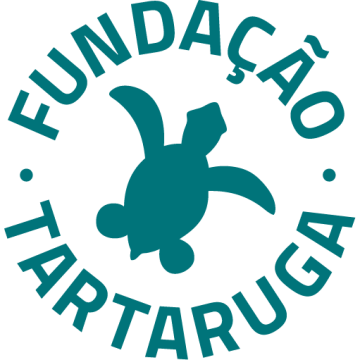
Conservation Dogs & Drones for the protection of endangered sea turtles in Cabo Verde
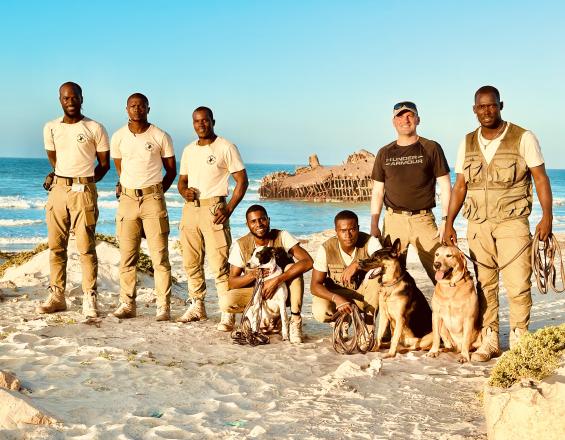
Cabo Verde is home of an endangered population of loggerhead turtles. The sea turtles are still being poached for their meat.
In order to further reduce poaching, a new project was launched in 2018 to develop and implement alternative conservation methods on the island of Boa Vista. Turtle Foundation (and the local implementing partner Fundação Tartaruga) provide extensive professional, financial, human, logistical and technical assistance to support the authorities' law enforcement efforts against sea turtle poaching. The project includes the use of protection dogs and modern night vision technology (drones and binoculars with thermal imaging technology) and their professional application within the framework of coordinated operational concepts and strategies. The aim is to deter poachers and, if this has not helped, to support prosecution by the authorities. This project was supported by the European Union and the Organisation of Africa, Carribean and pacific states through BIOPAMA program.
Context
Challenges addressed
Before the Turtle Foundation started its conservation project, 1,200 turtles were killed on the beaches of Boa Vista in 2007 alone. Conventional beach patrols have already brought about a considerable decrease in hunting, which is traditionally rooted in the rural population and has been considered illegal poaching since the legal protection of sea turtles in 1987. However, economic challenges like financial incentives from the meat, which is now traded as an expensive delicacy, and insufficient protection in some areas still led to the killing of almost 5% of nesting females in 2017.
Location
Process
Summary of the process
At the beginning of the project, the dog unit and a drone unit were set up and trained in parallel. With all the good initial successes of the project, it soon became clear that a lot of planning, organisational and practical work was still needed to meet the increasingly complex demands on the team and to put the successes on a sustainable footing.
While both project approaches were experimental and new to sea turtle conservation in the beginning, the strategies and procedures have continued to improve over the past years and we have merged both the dog and drone teams into one concept. The good relations and the trustful cooperation with the local authorities have been further deepened and the team members with their different competences have been welded together into an experienced and effective unit to fight sea turtle poaching.
Building Blocks
Application of a team of conservation dogs and dog-handlers
Dogs have a highly developed sense of smell that enables them to locate hidden objects and follow traces of odorous objects. Thanks to their excellent ability to perceive acoustic and olfactory impressions, they are the ideal complement to humans in detecting difficult-to-see situations despite the darkness. Because of this profile, conservation dogs can provide valuable services in tracking and tracing poachers, for example. Dogs are also increasingly used for research, surveillance and protection purposes on sea turtle nesting beaches.
The training of the dog handlers and the conservation dogs is done by an expert dog trainer. The dog trainer spends at least 6 weeks per year on the project side and accompanies the team with online trainings.
The dogs' most important task is to search larger areas during beach patrols in order to detect unauthorised persons. Furthermore, they are specially trained to detect turtle meat and are able to find it in travellers' luggage at ports and airports, as well as in houses and cars. The dogs are also trained in mantrailing. This means that they are able to follow poachers who have left objects such as clothing, knives or ropes at the scene of a crime to which their scent adheres. This supports the local law enforcement authorities to track and prosecute poachers.
Enabling factors
- a dog trainer who will supervise the project on a regular and long-term basis
- suitable dogs for which training as a conservation dog is possible
- dog handlers, who have a special talent and interest in the care and training of the dogs
- Specialized equipment which allows the team to provide the dogs with a good quality of life (food, medication, cooling blankets etc) and mobility (specially adapted car)
Lesson learned
- Dogs are living creatures that can also suffer injuries and become incapacitated. As we are already unable to use one dog as a working dog anymore, we are currently training 3 dogs in parallel in order to minimise the risk of failure.
- We started accompanying the dog team with the drone. In flight training and tactical lessons, the rangers learned to radio the information generated by the aircraft to the team on the ground. This allowed us to significantly increase the safety of the dog team on the ground.
- Apart from continuous training, the team also uses the sea turtle off-season to educate communities about our work and more broadly about sea turtles and environmental conservation. We organize events with schools and bring the dogs along to demonstrate their skills to the children. The dogs really capture the attention of children, which allows us to have important discussions about conservation while they interact with them.
Application of a team consists of drone pilots equipped with modern night vision technology (drones and binoculars with thermal imaging technology)
The drone unit started operational activity in August 2018 with a quadcopter drone equipped with a thermal night vision camera, because sea turtles’ nest at night. As the operation and use at night requires advanced skills, rangers are trained as drone pilots.
The mobile vehicle patrols cover daily several dozen kilometres of beach per night with high poaching risks. At strategically selected points or in case of suspicious circumstances (e.g. tyre or footprints), the patrols were stopped and the area was searched with the drone. A large part of these missions take place accompanied by one or two police officers. For operations without police, the authorities are to be alerted, as direct contact of the team with the offenders must be avoided.
Furthermore, the team is equipped with binoculars and radio devices. The rangers can communicate with each other practically at any time and without being noticed. This way they are virtually inaudible on the beach in the dark, but they always have all the information they need. Communication training in different situations is conducted regularly. So the rangers learn how to tell the team on the radio precisely what a person is doing on the beach, where they are and where they are going. A skill that enables the rangers to observe a suspect with the divided team.
Enabling factors
- quadcopter drone equipped with a thermal night vision camera
- further equipment like a vehicle, binoculars with thermal imaging technology, mobile phones, radio advices, batteries etc.
- special trained drone pilots, who have a special talent and interest in technical advises and strategic operation planning
- A project coordinator and trainer
- Effective and concise communication between team members
Lesson learned
Both the drone and the thermal imaging camera (including batteries) suffer from frequent use under harsh environmental conditions (sun, wind, salt, water) and need to be replaced regularly (approx. every three years).
There were changes in the personnel of both the dog handlers and the drone pilots. In order to compensate for the absence of team members more quickly in the future, we decided to train the rangers in two ways. They now learn not only to lead a dog, but also to fly a drone in an emergency and vice versa.
Close cooperation with law enforcement authorities
The Turtle Foundation maintains a very close relationship with the local conservation authority and the national police for several years. We provide extensive professional, financial, human, logistical and technical assistance to support the authorities' law enforcement efforts against sea turtle poaching.
The project includes the use of conservation dogs and modern night vision technology (drones and binoculars with thermal imaging technology) and their professional application within the framework of coordinated operational concepts and strategies. The operational concepts are developed in cooperation with the police, who partly accompany the operations or are on call in case our teams uncover a poaching case.
While previous strategies focused mainly on preventing poaching activities through the presence of rangers and volunteers on the beaches, the more proactive approach of the Dog & Drone team involves detection, intervention and prosecution of poaching activities.
Enabling factors
- Good relationship with the local authorities
- The local authorities must be willing to prevent poaching and to prosecute poachers
- Availability of law enforcement agents to participate in missions
Lesson learned
Education of local law enforcement agents about the ecology and significance of sea turtles helped a lot to engage and motivate them in the protection of sea turtles. Before this project, many police officers had never even seen a turtle or knew about their life cycle.
As the team patrols 5 protected areas island wide, good relations and communication with other NGOs and local communities are necessary.
Impacts
With the combination of the conservation dogs and the drone technology, we developed a new operational strategy to prevent poaching. This improved the efficiency of patrols as well as reduced dense and expensive beach patrols. The dog and drone team is now patrolling 66 km of beach in 5 protected areas on Boa Vista island.
In the first year of project initiation, the rate of recorded killed turtles decreased by nearly 90% from 4.5% to 0.5%. The rate continued to decline and was 0.3% in the 2022 nesting season. Further, three poachers were arrested by the police as a result of the Sea Turtle Dog & Drone Team's activity. Various aspects may be involved in the significant reduction of poaching in recent years, such as a legal tightening of penalties for poaching and expansion of NGO community programs. However, we have learned from direct sources such as the testimony of former poachers that the significantly increased risk of being caught regularly deterred potential offenders from their intentions.
While many of the project's approaches were experimental and new to sea turtle conservation, strategies and operations have improved significantly in the past five years. Good relations and trustful cooperation with the local authorities were further deepened and the team members with their different competences welded together to form an experienced and effective anti-sea turtle poaching unit.
Beneficiaries
- 7 local rangers, who have year-round employment and receive regular training
- The local law enforcement agencies
- The local community benefits indirectly through the conservation of an emblematic species
Sustainable Development Goals
Story
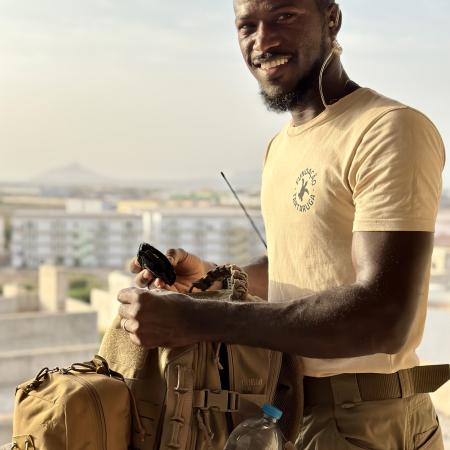
Adilson Ramos is a Capeverdean and coordinator of the dog and drone team. He tells us how far the team has already helped to prevent poaching: "During the 2021 nesting season, three poachers were arrested on Boa Vista, involved in two cases of poaching. In both cases, the Dog & Drone team was involved in reporting and solving the case; the second case was also the first time poachers were directly arrested during an operation."
Adilson continues: "The first case occurred in July 2021 in northern Boa Vista. A freshly killed loggerhead turtle was found in the morning by our rangers on the beach and reported to the Dog & Drone team. An investigation revealed that a man was selling turtle meat in the village of João Galego. I called the police immediately and the man was arrested. The second case occurred on Morabeza beach in the west of Boa Vista in August 2021. During an operation, the security guard of a restaurant informed about suspicious persons who had passed by some time before. Immediately, the drone was sent into the air and one person was identified in suspicious activity. Our team approached the location of the person, who then tried to hide in the dunes. However, the person was found and the police were called, who arrested the person. A freshly killed turtle was also found at this location. Later, a second person involved in the case was also arrested. As it was suspected that the perpetrators tried to hide evidence during their escape attempts, a follow-up search with the dogs was carried out in the morning of the following day. In the process, a buried knife was found, which could be clearly attributed to the crime and the perpetrators. The perpetrators were later brought before the court and sentenced to fines."
Adilson reports that it is cases like this that motivate him and his team to stand up for the turtles and put an end to poaching in Cape Verde for good.



